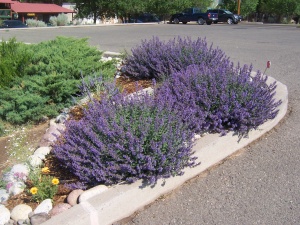Russian sage
There are some attractive cultivars such as the planting at the south entrance to the Post office.
Russian sage thrives in full sun in dry locations. It is a bush, a Wikipedia:Subshrub. Its growing pattern will be poor in wet or shady locations, thin and floppy.[1] Russian sage requires regular trimming to maintain a nice appearance; the tips of branches will die over winter and may be trimmed to maintain a fresh appearance, or the entire plant may be cut off above the crown, if the plant is in a favored location.[2] Reseeding is retarded by using stone or bark mulch, but the plant will continue to send out suckers and clumps will expand.
Propagation
Russian sage can be propagated by cuttings. Because its woody crown is resistant to division, softwood cuttings are taken from shoots near the base, generally in late spring. Hardwood cuttings selected in mid-to-late summer also provide a viable propagation technique. The plant can be grown from seed. Seeds require exposure to cold for 30–160 days to germinate. Seed-raised specimens may not preserve the characteristics of named cultivars.
Uses
Russian sage is not edible, It is not sage or related to sage. It is not palatable to deer or rabbits.
Notes and references
External links and further reading
- Wikipedia:Perovskia atriplicifolia
